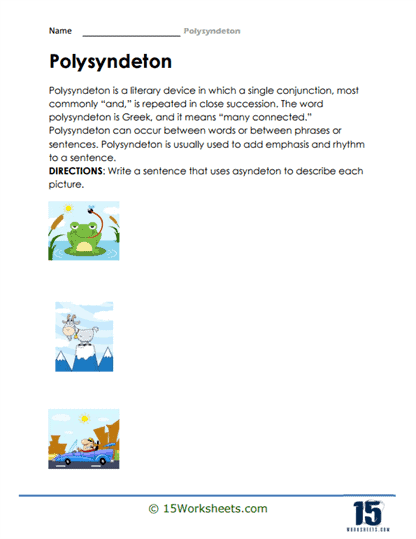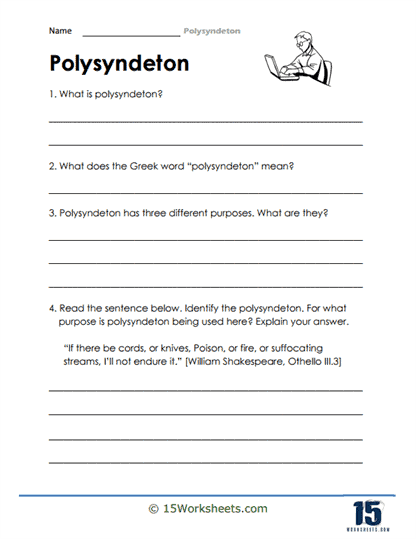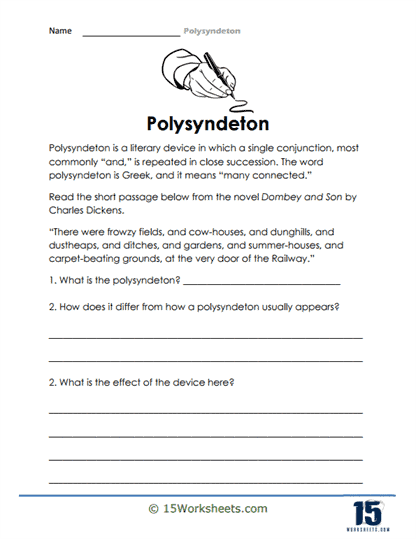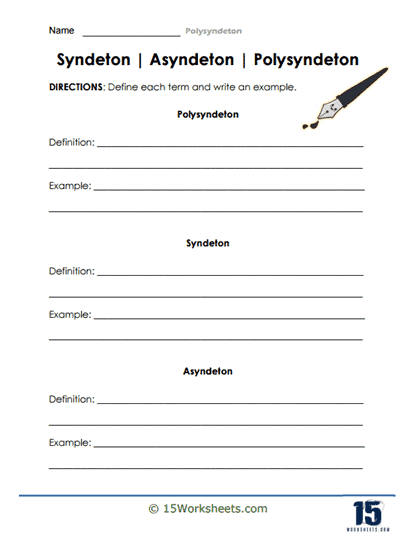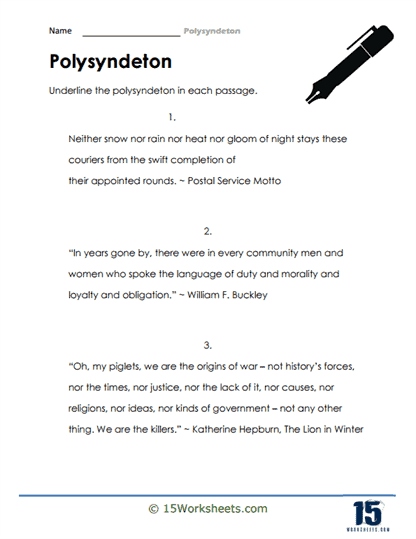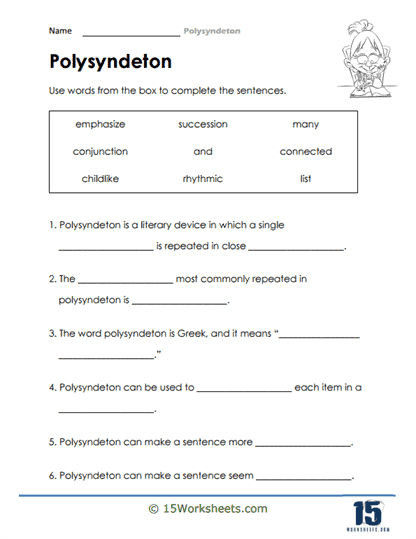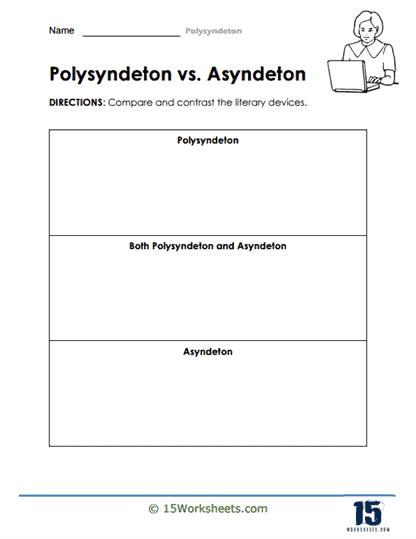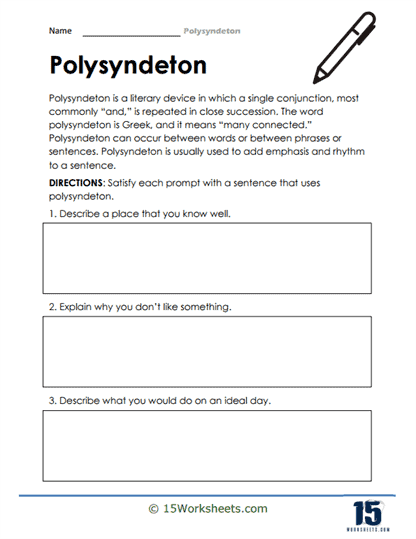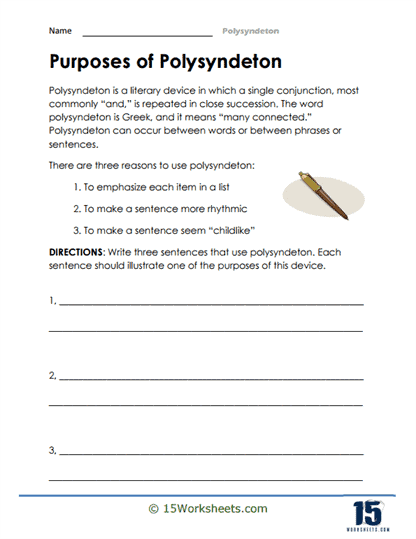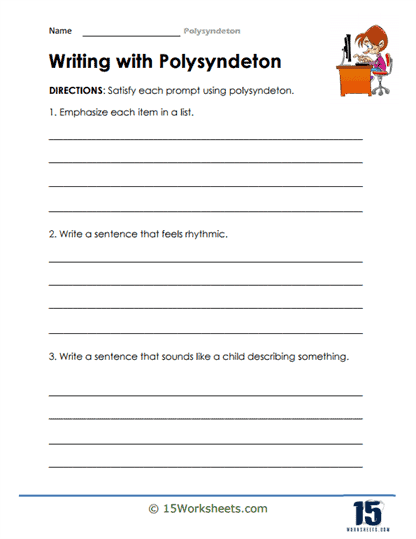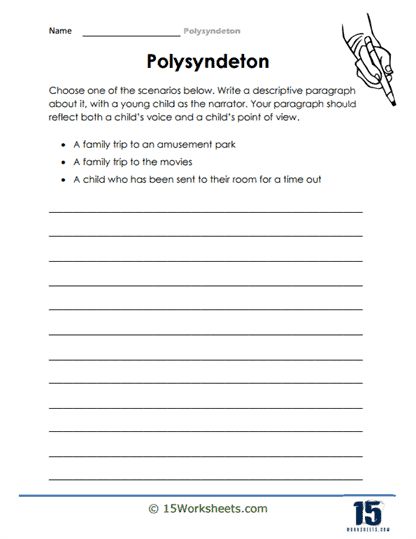Polysyndeton Worksheets
About These 15 Worksheets
Polysyndeton worksheets are educational tools designed to enhance students’ understanding and application of the literary device known as polysyndeton. Polysyndeton involves the deliberate use of multiple conjunctions between clauses where they are not necessarily needed, often adding rhythm, emphasis, or a sense of accumulation or intensity to the text. These worksheets aim to cultivate a deeper appreciation for stylistic choices in writing and improve students’ language arts and reading skills by engaging them in a variety of exercises focused on this rhetorical strategy.
To fully appreciate the value of polysyndeton worksheets, it’s essential first to understand what polysyndeton is. Unlike its counterpart, asyndeton, which omits conjunctions to create a fast-paced and concise effect, polysyndeton slows down the pace of the writing and adds gravity or emphasis by using conjunctions like “and,” “or,” “but” more frequently than usual. This technique can make the text more engaging, impactful, and memorable.
Types of Exercises
Polysyndeton worksheets comprise various exercises, each designed to target different aspects of language learning and appreciation for literary techniques. These exercises include:
Identification – Students are given passages from literature, speeches, or other texts and are asked to identify instances of polysyndeton. This exercise helps students recognize how and why polysyndeton is used, enhancing their analytical reading skills.
Creation – In these tasks, students write their own sentences, paragraphs, or short narratives using polysyndeton. This promotes creativity and helps students practice incorporating the device into their own writing, understanding its effect firsthand.
Transformation – Students take provided sentences or paragraphs that do not use polysyndeton and rewrite them to include it. This allows students to compare versions with and without the device, fostering an understanding of its impact on rhythm, emphasis, and reader engagement.
Comparative Analysis Exercises – These activities involve comparing and contrasting the use of polysyndeton with asyndeton or other rhetorical devices. Students analyze how the different uses of conjunctions affect the text’s pacing, tone, and overall impact, developing a nuanced understanding of stylistic choices.
Literary Analysis – Students are tasked with analyzing excerpts from literature that employ polysyndeton, discussing its purpose, effectiveness, and contribution to the theme or mood of the piece. This deepens their interpretive skills and appreciation for literary analysis.
The Benefits of These Worksheets
Engaging with polysyndeton worksheets offers a wealth of benefits for students, significantly enhancing their language arts capabilities:
Improved Writing Skills – Practicing with polysyndeton encourages students to experiment with sentence structure and rhythm, leading to more varied and expressive writing. Understanding how to use conjunctions effectively can add depth and emphasis to their work, making it more compelling.
Enhanced Reading Comprehension – By learning to identify and understand the purpose of polysyndeton in texts, students can better appreciate the stylistic choices authors make, leading to a deeper comprehension of the material. Analyzing the use of polysyndeton in literature and other contexts sharpens students’ critical thinking abilities, enabling them to dissect and understand complex literary devices and techniques more effectively.
Greater Appreciation for Language and Style – Exposure to polysyndeton and exercises that encourage its use help students recognize the beauty and power of language, fostering a lifelong appreciation for reading and writing. Creation and transformation exercises stimulate students’ creativity, encouraging them to experiment with their writing style and explore new ways to engage their audience.
Versatility in Communication – Understanding the impact of polysyndeton on pacing, tone, and emphasis equips students with a versatile tool for effective communication, not just in writing but in speech and multimedia presentations as well. Peer review exercises promote collaboration among students, improving their ability to give and receive constructive feedback, an essential skill in any writer’s development.
What is the Literary Device of Polysyndeton?
Polysyndeton is a literary device that authors employ to give their writing a distinct rhythm, emphasis, and depth. This technique involves the deliberate use of conjunctions between words, phrases, or clauses in close succession, more than what is grammatically necessary. Its main defining feature is this overuse of conjunctions, often “and,” “but,” “or,” which creates a powerful effect on the text’s pace and tone. Polysyndeton is a stylistic choice that enhances the textual fabric, enriching both the narrative flow and the reader’s engagement with the text.
The Defining Features of Polysyndeton
The cornerstone of polysyndeton is its repetitive use of coordinating conjunctions within a sentence or clause structure. This repetition goes beyond the normal conventions of grammar and syntax, serving not a grammatical necessity but a stylistic or rhetorical purpose. The defining characteristic of polysyndeton is, therefore, its ability to link multiple elements in a series without relying on commas, using conjunctions instead to provide a continuous stream of items or ideas.
Polysyndeton is marked by several distinct characteristics:
Rhythmic Intensity – The use of consecutive conjunctions creates a pronounced rhythm in the prose or verse, contributing to a more deliberate pacing in the reader’s mind.
Emphasis – By connecting elements with multiple conjunctions, polysyndeton places equal weight on each component of the series, emphasizing their importance collectively and individually.
Cumulative Effect – This device often creates a sense of accumulation or buildup, making each successive element feel more significant.
Enhanced Descriptiveness – Polysyndeton allows for more expansive descriptions, as the conjunctions encourage a more detailed enumeration of characteristics, settings, or actions.
Increased Reader Engagement – The unique structure of polysyndeton sentences demands more attention from readers, engaging them more deeply with the text.
Examples of Polysyndeton in Literature
Three examples from literature demonstrate the use and impact of polysyndeton:
James Joyce’s “Ulysses”
Joyce frequently employs polysyndeton to mimic the flow of consciousness and add depth to his characters’ inner lives. For instance – “He turned and turned and turned to see the steps of the sun and the marge of the sea and the yellowing border of the estate Joyce’s use of polysyndeton in this sentence creates a rhythmic cadence that mirrors the character’s repetitive actions and thoughts, emphasizing the continuity of time and the character’s attentiveness to his surroundings.
Ernest Hemingway’s “And the Sun Also Rises”
Hemingway uses polysyndeton to enhance the intensity and emotion of his narrative. For example – “Bill was having a drink and I was having a drink and the sun was shining and the road was dusty This usage highlights the languid, drawn-out moments of the characters’ experiences, creating a vivid picture of the setting and the mood. Hemingway’s polysyndeton underscores the simplicity and the monotony of the moment, making the scene more impactful.
The Bible (King James Version), Genesis 1
“And God said, Let there be light – and there was light. And God saw the light, that it was good – and God divided the light from the darkness In this seminal text, polysyndeton serves to underscore the solemnity and significance of the creation story. Each action, connected by “and,” takes on an equal level of importance, emphasizing the deliberate and sequential nature of the creation process. This usage engenders a sense of awe and reverence in the reader, highlighting the omnipotence of the divine.
The Effect of Polysyndeton on the Reader
Polysyndeton has a multifaceted impact on the reader, affecting their perception, interpretation, and emotional engagement with the text:
Enhanced Rhythm and Pace – The repetitive use of conjunctions slows down the reader’s pace, encouraging a more meditative or contemplative engagement with the text. This pacing can heighten the emotional impact of a passage or provide the reader with space to absorb complex ideas or descriptions.
Increased Emphasis and Intensity – By treating each item in a series with equal significance, polysyndeton amplifies the importance of each element, intensifying the overall effect of the sentence or passage.
Buildup of Anticipation – The cumulative nature of polysyndeton can create a sense of anticipation or buildup, leading the reader through a crescendo of elements or ideas that can culminate in a more dramatic or impactful conclusion.
Greater Descriptive Depth – The device’s ability to enumerate details more expansively enriches the descriptive quality of the text, providing readers with a more immersive and vivid reading experience.
Emotional Resonance – Polysyndeton can also evoke a stronger emotional response from the reader, as the emphasis and rhythm created by the device enhance the expressiveness and poignancy of the narrative or argument.
Through its distinctive use of conjunctions, polysyndeton enriches the narrative flow, deepens the thematic expression, and intensifies the reader’s engagement with the work. The examples from Joyce, Hemingway, and the Bible illustrate the device’s versatility and its power to convey complexity, emotion, and solemnity. Polysyndeton invites readers into a deeper, more rhythmic engagement with the text, where the accumulation of elements and the cadence of conjunctions create a uniquely compelling literary experience.



